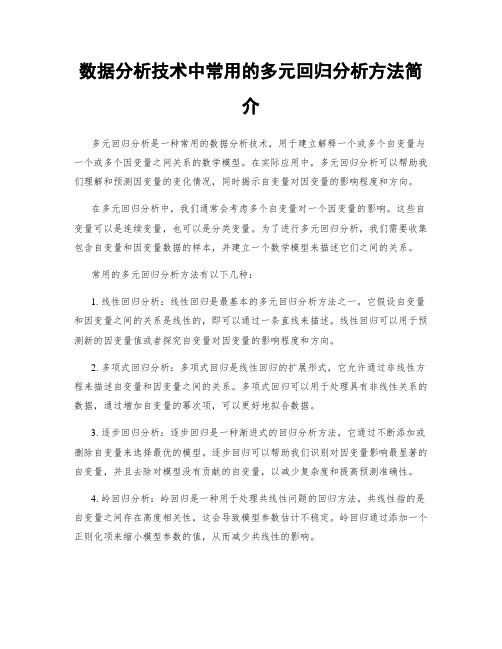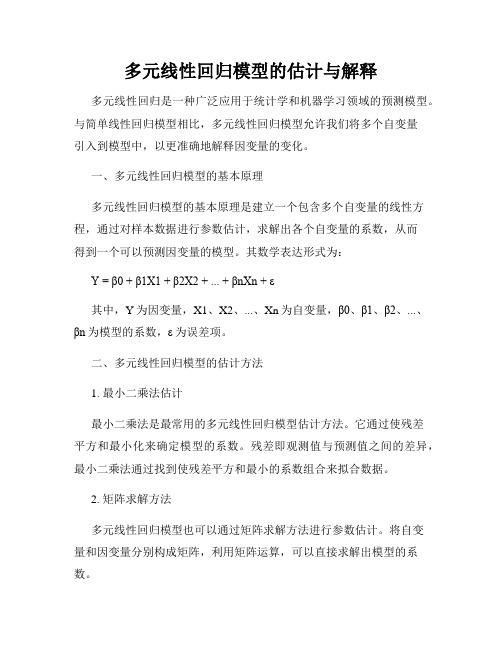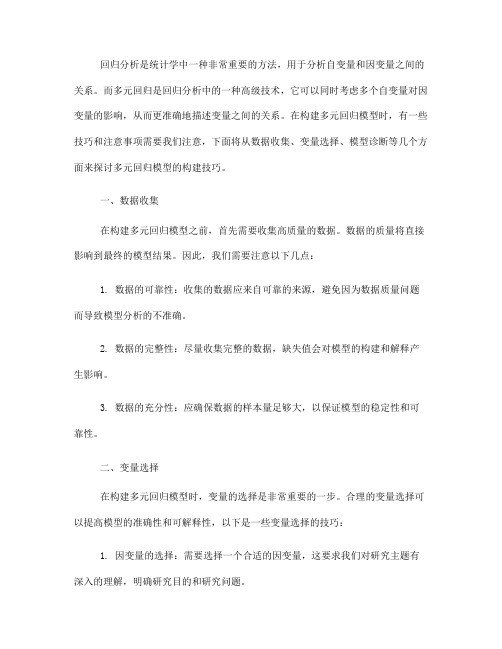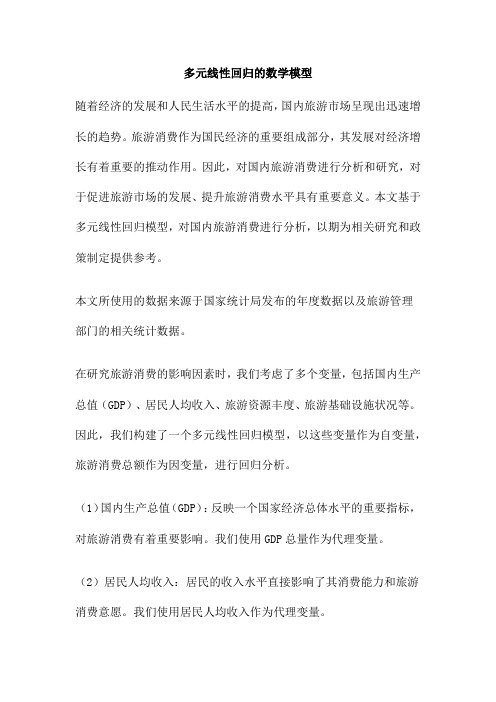多元回归分析模型识别和数据问题.
多元统计分析的基本方法及应用

多元统计分析的基本方法及应用多元统计分析是一种基于多个变量的统计分析方法。
它是对各个变量之间关系进行分析,并进行统计推断和验证的过程。
多元统计分析涉及到多种统计方法和技术,包括多元回归分析、因子分析、聚类分析、判别分析、主成分分析、多维尺度分析等。
这些方法和技术可以用于数据挖掘、市场分析、信用风险评估、社会科学、心理学等领域的研究和应用。
一、多元回归分析多元回归分析是一种常用的统计工具,它可以通过控制一些其他变量,来了解某个变量与另一个变量的关系。
多元回归分析可以用来解决预测问题、描述性问题和推理性问题。
多元回归分析可以针对具有多个解释变量和一个目标变量的情况进行分析。
在多元回归分析中,常用的方法包括线性回归、非线性回归、逻辑回归等。
二、因子分析因子分析是一种多元统计方法,它可以用来描述一组变量或观测数据中的共同性和特征。
因子分析的基本思想是将多个相关变量归纳为一个因子或因子组合。
因子分析可以用于数据压缩、变量筛选和维度识别等方面。
当研究者需要解释多个变量间的关系时,因子分析可以起到非常有效的作用。
三、聚类分析聚类分析是一种基于数据相似性的分析技术。
它通过对数据集进行分类,寻找数据集内的同类数据,以及不同类别之间的差异。
聚类分析可以用于寻找规律、发现规律、识别群体、分类分析等方面。
聚类分析常用的方法包括层次聚类和K均值聚类。
四、判别分析判别分析是一种多元统计方法,它可以用来判别不同群体之间的差异。
这种方法可以用于市场研究、医学研究、生物学研究、工业控制等方面。
判别分析可以通过寻找差异来帮助研究者识别一组变量或因素,以及预测这些结果的影响因素,从而帮助他们更好地理解数据和结果。
五、主成分分析主成分分析是一种多元统计分析方法,它可以用来简化一组变量或因子数据。
这种方法通过对数据进行降维操作,找出影响数据最大的因素和变量组合,从而达到简化数据的目的。
主成分分析可以用于数据可视化、数据分析、特征提取等方面。
多元回归分析的步骤

多元回归分析的步骤1.确定研究问题和目标:在开始多元回归分析之前,需要明确研究问题和目标。
这有助于确定所需的数据、研究变量,以及模型的选择。
2.收集数据:收集包含自变量和因变量的数据样本。
通常需要收集一定量的数据,以确保模型具有足够的准确性和可靠性。
3.数据清理和准备:对数据进行清理和准备是确保多元回归分析准确性的重要步骤。
这包括检查数据是否完整、是否存在异常值、缺失值如何处理等。
4.确定模型:在多元回归分析中,需要选择适当的模型来描述自变量与因变量之间的关系。
根据问题的需求和理论背景,可以选择线性回归模型、非线性回归模型、对数线性模型等。
5.模型适合度检验:在建立模型后,需要对模型的适合度进行评估。
常见的方法包括残差分析、F检验和决定系数(R2)的计算。
6.变量选择:根据研究目标和模型的适合度,可以选择保留所有自变量或根据统计和经验的指导进行变量选择。
常见的方法包括逐步回归、前向选择和后向消元。
7.假设检验:在多元回归分析中,可以进行假设检验以确定自变量的显著性。
常见的假设包括检验系数是否为零,同时也可以检验模型整体的显著性。
8.解释结果:根据分析结果和统计显著性,解释模型中自变量对因变量的影响程度和方向。
注意要提供有关变量关系的详细解释和背景信息。
9.预测:基于建立的多元回归模型,可以使用新的自变量数据来预测因变量的值。
这可以帮助我们了解自变量的实际影响,并进行未来趋势的预测。
10.总结和报告:最后,将所有的分析结果进行总结和报告。
包括数据的清晰展示、统计显著性的解释、模型的解释力和预测能力的评估等。
总之,多元回归分析是一个复杂的过程,需要仔细的计划和执行。
它可以帮助我们了解变量之间的关系,对因变量的影响进行量化,并预测未来的趋势。
在进行多元回归分析时,需根据具体问题、数据质量和研究目标来选择合适的方法和步骤。
多元回归分析模型识别和数据问题

Functional Form (continued)
WmihWhsiegsehtpaleholrergeeo(cawrrddaiyfegtirehek)tneed=ormwb?m0s+hooobrw1dientdetoeulrctae+ycsttibjo=2oneisnxbptbe0eerxlo++cnlbug3bstiieon1nnxuthr1reees++mtruoic…dteioln+s tobskexekif+u RESEl+ogTb(6wtreaenguelr)iee=2 +sb0b+7oebdn1uecda•utecnt+urribce+2keuxpseirm+bi3latenrutreo+tbh4eedusc2p+ebc5 eiaxpler2
abil=d0 +d1IQ+ v Assume E(v |educ, exper, IQ)= 0
so we use IQ as a proxy for ability. And the estimated model is
log(wage) = b0* + b1educ + b2exper + b3*IQ + u*
log(wage)=b0 + b1 educ + u, or log(educ) as
independent variable
数据分析技术中常用的多元回归分析方法简介

数据分析技术中常用的多元回归分析方法简介多元回归分析是一种常用的数据分析技术,用于建立解释一个或多个自变量与一个或多个因变量之间关系的数学模型。
在实际应用中,多元回归分析可以帮助我们理解和预测因变量的变化情况,同时揭示自变量对因变量的影响程度和方向。
在多元回归分析中,我们通常会考虑多个自变量对一个因变量的影响。
这些自变量可以是连续变量,也可以是分类变量。
为了进行多元回归分析,我们需要收集包含自变量和因变量数据的样本,并建立一个数学模型来描述它们之间的关系。
常用的多元回归分析方法有以下几种:1. 线性回归分析:线性回归是最基本的多元回归分析方法之一。
它假设自变量和因变量之间的关系是线性的,即可以通过一条直线来描述。
线性回归可以用于预测新的因变量值或者探究自变量对因变量的影响程度和方向。
2. 多项式回归分析:多项式回归是线性回归的扩展形式,它允许通过非线性方程来描述自变量和因变量之间的关系。
多项式回归可以用于处理具有非线性关系的数据,通过增加自变量的幂次项,可以更好地拟合数据。
3. 逐步回归分析:逐步回归是一种渐进式的回归分析方法,它通过不断添加或删除自变量来选择最优的模型。
逐步回归可以帮助我们识别对因变量影响最显著的自变量,并且去除对模型没有贡献的自变量,以减少复杂度和提高预测准确性。
4. 岭回归分析:岭回归是一种用于处理共线性问题的回归方法。
共线性指的是自变量之间存在高度相关性,这会导致模型参数估计不稳定。
岭回归通过添加一个正则化项来缩小模型参数的值,从而减少共线性的影响。
5. 主成分回归分析:主成分回归结合了主成分分析和回归分析的方法,用于处理多重共线性问题。
主成分分析通过将自变量转换为一组无关的主成分来降维,然后进行回归分析。
这样可以减少自变量之间的相关性,并提高模型的解释力。
6. 逻辑回归分析:逻辑回归是一种广义线性回归,常用于处理二分类问题。
它通过对因变量进行逻辑变换,将线性回归的结果映射到一个[0, 1]的区间,表示某事件发生的概率。
多元线性回归模型的估计与解释

多元线性回归模型的估计与解释多元线性回归是一种广泛应用于统计学和机器学习领域的预测模型。
与简单线性回归模型相比,多元线性回归模型允许我们将多个自变量引入到模型中,以更准确地解释因变量的变化。
一、多元线性回归模型的基本原理多元线性回归模型的基本原理是建立一个包含多个自变量的线性方程,通过对样本数据进行参数估计,求解出各个自变量的系数,从而得到一个可以预测因变量的模型。
其数学表达形式为:Y = β0 + β1X1 + β2X2 + ... + βnXn + ε其中,Y为因变量,X1、X2、...、Xn为自变量,β0、β1、β2、...、βn为模型的系数,ε为误差项。
二、多元线性回归模型的估计方法1. 最小二乘法估计最小二乘法是最常用的多元线性回归模型估计方法。
它通过使残差平方和最小化来确定模型的系数。
残差即观测值与预测值之间的差异,最小二乘法通过找到使残差平方和最小的系数组合来拟合数据。
2. 矩阵求解方法多元线性回归模型也可以通过矩阵求解方法进行参数估计。
将自变量和因变量分别构成矩阵,利用矩阵运算,可以直接求解出模型的系数。
三、多元线性回归模型的解释多元线性回归模型可以通过系数估计来解释自变量与因变量之间的关系。
系数的符号表示了自变量对因变量的影响方向,而系数的大小则表示了自变量对因变量的影响程度。
此外,多元线性回归模型还可以通过假设检验来验证模型的显著性。
假设检验包括对模型整体的显著性检验和对各个自变量的显著性检验。
对于整体的显著性检验,一般采用F检验或R方检验。
F检验通过比较回归平方和和残差平方和的比值来判断模型是否显著。
对于各个自变量的显著性检验,一般采用t检验,通过检验系数的置信区间与预先设定的显著性水平进行比较,来判断自变量的系数是否显著不为零。
通过解释模型的系数和做假设检验,我们可以对多元线性回归模型进行全面的解释和评估。
四、多元线性回归模型的应用多元线性回归模型在实际应用中具有广泛的应用价值。
回归分析中的多元回归模型构建技巧

回归分析是统计学中一种非常重要的方法,用于分析自变量和因变量之间的关系。
而多元回归是回归分析中的一种高级技术,它可以同时考虑多个自变量对因变量的影响,从而更准确地描述变量之间的关系。
在构建多元回归模型时,有一些技巧和注意事项需要我们注意,下面将从数据收集、变量选择、模型诊断等几个方面来探讨多元回归模型的构建技巧。
一、数据收集在构建多元回归模型之前,首先需要收集高质量的数据。
数据的质量将直接影响到最终的模型结果。
因此,我们需要注意以下几点:1. 数据的可靠性:收集的数据应来自可靠的来源,避免因为数据质量问题而导致模型分析的不准确。
2. 数据的完整性:尽量收集完整的数据,缺失值会对模型的构建和解释产生影响。
3. 数据的充分性:应确保数据的样本量足够大,以保证模型的稳定性和可靠性。
二、变量选择在构建多元回归模型时,变量的选择是非常重要的一步。
合理的变量选择可以提高模型的准确性和可解释性,以下是一些变量选择的技巧:1. 因变量的选择:需要选择一个合适的因变量,这要求我们对研究主题有深入的理解,明确研究目的和研究问题。
2. 自变量的选择:选择自变量时需要注意自变量之间的相关性,避免多重共线性问题。
同时,还需要考虑自变量与因变量之间的相关性,选择与因变量具有显著相关性的自变量进行建模。
三、模型诊断在构建多元回归模型后,还需要进行模型诊断,以验证模型的有效性和稳定性。
模型诊断通常包括以下几个方面:1. 残差分析:通过对模型的残差进行分析,来检验模型的拟合程度和误差性质,进而评估模型的有效性。
2. 多重共线性检验:多重共线性会导致模型参数估计的不准确,因此需要对模型中的自变量之间的相关性进行检验。
3. 异方差性检验:异方差性会使得模型的标准误差产生偏差,影响参数估计的有效性,需要进行相应的检验和处理。
四、模型解释最后,构建多元回归模型的目的之一是对变量之间的关系进行解释。
在模型解释时,需要注意以下几点:1. 参数的解释:需要深入理解模型中各个参数的物理含义,将其转化为实际问题的解释,以便更好地理解自变量对因变量的影响。
多元回归分析及其应用

多元回归分析及其应用多元回归分析是一种统计分析方法,可以用来研究多个自变量对一个因变量的影响关系。
相比于简单回归分析,多元回归分析考虑了更多因素的影响,能够更准确地描述变量之间的关系。
本文将介绍多元回归分析的基本原理和应用,以及如何进行该分析的步骤和解读结果。
一、多元回归分析的基本原理多元回归分析建立在线性回归的基础上,使用线性方程来描述因变量与自变量之间的关系。
它的基本模型可以表示为:Y = β0 + β1X1 + β2X2 + ... + βnXn + ε其中,Y表示因变量,X1、X2...Xn表示自变量,β0、β1...βn表示模型的系数,ε表示误差项。
多元回归分析的目标是通过拟合最佳的模型,得到各个自变量的系数,以及判断自变量对因变量的影响是否显著。
二、多元回归分析的步骤进行多元回归分析时,需要按照以下步骤进行:1. 数据收集与准备:收集与研究问题相关的数据,并进行数据清洗与整理,确保数据的准确性和完整性。
2. 模型设定:根据研究问题和数据特点,选择适当的模型。
根据自变量和因变量的关系类型,可以选择线性回归、多项式回归、对数回归等各种模型。
3. 模型拟合:使用统计软件进行多元回归分析,拟合出最佳模型。
统计软件会给出各个自变量的系数、截距项以及模型的可靠性指标。
4. 模型诊断:对模型进行诊断,检查模型的合理性和符合假设的程度。
可以通过观察残差图、相关系数矩阵、变量的显著性检验等方法来评估模型的质量。
5. 结果解读:根据模型的系数和统计指标,对结果进行解读。
判断自变量对因变量的影响是否显著,并分析各个自变量之间的相互影响。
三、多元回归分析的应用领域多元回归分析在各个学科和领域都有广泛的应用。
以下是其中几个具体领域的示例:1. 经济学:多元回归分析可以用来研究经济变量之间的关系,如GDP、失业率、通货膨胀率等。
2. 医学:多元回归分析可以帮助医学研究人员研究不同因素对疾病发展的影响,如药物剂量、生活方式等。
多元回归分析的关键要点

多元回归分析的关键要点多元回归分析是一种常用的统计分析方法,用于研究多个自变量对一个因变量的影响程度和关系。
在进行多元回归分析时,有一些关键要点需要注意和掌握。
本文将介绍多元回归分析的关键要点,包括模型设定、变量选择、模型检验和解释结果等方面。
一、模型设定在进行多元回归分析之前,首先需要设定一个合适的模型。
模型设定包括确定因变量和自变量,以及确定模型的形式。
在选择因变量时,需要明确研究的目的和问题,选择与问题相关的变量作为因变量。
在选择自变量时,需要考虑自变量与因变量之间的理论联系和实际可操作性,选择与因变量相关的自变量。
模型的形式可以是线性模型、非线性模型或者其他形式的模型,根据实际情况选择合适的模型形式。
二、变量选择在进行多元回归分析时,变量选择是非常重要的一步。
变量选择的目的是从众多自变量中选择出对因变量有显著影响的变量,排除对因变量没有显著影响的变量。
变量选择可以采用逐步回归法、前向选择法、后向选择法等方法。
逐步回归法是一种常用的变量选择方法,它通过逐步添加和删除自变量,选择出对因变量有显著影响的自变量。
三、模型检验在进行多元回归分析后,需要对模型进行检验,以评估模型的拟合程度和稳定性。
常用的模型检验方法包括残差分析、方差分析、显著性检验等。
残差分析可以用来检验模型的拟合程度,通过观察残差的分布和模式,判断模型是否合理。
方差分析可以用来检验模型的显著性,通过计算F值或者t值,判断模型的显著性。
显著性检验可以用来检验模型中各个自变量的显著性,通过计算p值,判断自变量是否对因变量有显著影响。
四、解释结果在进行多元回归分析后,需要对结果进行解释和说明。
解释结果包括解释模型的系数、解释模型的拟合程度和解释模型的显著性。
解释模型的系数可以通过计算回归系数的大小和方向,判断自变量对因变量的影响程度和方向。
解释模型的拟合程度可以通过计算决定系数R^2,判断模型对观测数据的拟合程度。
解释模型的显著性可以通过计算p 值,判断模型的显著性。
报告中实证研究的多元回归分析和解释方法

报告中实证研究的多元回归分析和解释方法多元回归分析是实证研究中常用的一种统计方法,它可以帮助研究者探索多个自变量对因变量的影响,并解释这种影响的原因。
在这篇文章中,我将使用六个标题进行详细论述多元回归分析的方法和应用。
一、多元回归分析简介在这一部分,我将介绍多元回归分析的基本概念和步骤。
我会解释多元回归方程的形式,并讨论如何选择适当的自变量和建立模型。
此外,我还将介绍各类统计软件如何进行多元回归分析,并讨论结果的解释方法。
二、变量选择与建模在这一部分,我将探讨如何选择适当的自变量,并建立合适的多元回归模型。
我将介绍常用的变量选择方法,如前向逐步回归和后向逐步回归,并讨论其优缺点。
此外,我还会介绍各类变量间的关系如何进行建模,并解释如何进行变量转换和处理。
三、共线性问题与处理在这一部分,我将讨论多元回归分析中常见的共线性问题以及处理方法。
我会介绍共线性的概念,并讨论如何使用方差膨胀因子(VIF)来诊断和解决共线性问题。
此外,我还会介绍常用的处理共线性的方法,如主成分分析和岭回归。
四、回归系数的解释与显著性检验在这一部分,我将详细讨论回归系数的解释和显著性检验方法。
我会介绍如何解释回归系数的大小和方向,以及如何解释截距项的含义。
此外,我还会讨论如何使用t检验和F检验来进行回归系数的显著性检验,并解释其统计意义。
五、模型拟合与验证在这一部分,我将讨论多元回归模型的拟合程度和验证方法。
我会介绍R平方值和调整R平方值的概念,并解释如何解释它们。
此外,我还会介绍残差分析的方法,以及如何使用交叉验证和留一验证来验证模型的准确性和稳健性。
六、解释与推断在这一部分,我将探讨多元回归分析的解释和推断方法。
我会介绍如何解释回归模型的结果和推断自变量对因变量的影响。
此外,我还会讨论如何解释交互作用和非线性效应,并引入因果推断的概念和方法。
通过以上六个标题的详细论述,读者将能够了解多元回归分析的基本方法、变量选择与建模的技巧、共线性问题与处理方法、回归系数的解释与显著性检验、模型拟合与验证的方法,以及解释与推断的技巧。
多元线性回归模型分析

多元线性回归模型分析
例:
Ct
β 1
Hale Waihona Puke β2Dtβ3Lt
ut
其中,Ct=消费,Dt=居民可支配收入 Lt=居民拥有的流动资产水平
β2的含义是,在流动资产不变的情况下,可支配收入变动一个 单位对消费额的影响。这是收入对消费额的直接影响。
收入变动对消费额的总影响=直接影响+间接影响。
(间接影响:收入流动资产拥有量消费额)
但在模型中这种间接影响应归因于流动资产,而不是收入,因 而,β2只包括收入的直接影响。 在下面的模型中:
Ct Dt ut , t 1,2,..., n
这里,β是可支配收入对消费额的总影响,显然β和β2的含义 是不同的。偏回归系数bj就多是元x线j性本回身归模变型分化析对y的直接(净)影响。
多元线性回归模型分析
要使残差平方和
Q ei2 Yi βˆ1Xi1 ... βˆK XiK 2
为最小,则应有:
Q
ˆ1
0,
...,
Q
ˆK
0
于是得到关于待估参数估计值的K个方程(即正规方程组):
多元线性回归模型分析
β1
X
2 i1
......
βK
Xi1XiK
X i1Yi
β1 Xi2Xi1 ...... β K Xi2XiK Xi2Yi
且所获得的是诸变量X值固定时Y的平均值。诸i称
为偏回归系数(partial regression coefficients)。
多元线性回归模型分析
▪偏回归系数的含义如下: 1度量着在X2,X3,…,Xk保持不变的情况下,X1
每变化1个单位时,Y的均值E(Y)的变化,或者说1 给出X1的单位变化对Y均值的“直接”或“净”(不含 其他变量)影响。
回归分析中的多元回归模型构建技巧(十)

回归分析中的多元回归模型构建技巧回归分析是一种统计学方法,用来探索变量之间的关系,并预测一个或多个自变量对因变量的影响。
而多元回归模型则是回归分析中的重要方法之一,用来探究多个自变量对因变量的影响。
在构建多元回归模型时,需要注意一些技巧,以确保模型的有效性和准确性。
1. 数据准备在构建多元回归模型之前,首先需要准备好相关的数据。
这包括自变量和因变量的数据,以及可能影响因变量的其他变量的数据。
在选择数据时,需要确保数据的准确性和完整性,避免缺失值和异常值对模型的影响。
同时,还需要对数据进行适当的转换和处理,以满足多元回归模型的假设。
2. 变量选择在构建多元回归模型时,需要选择适当的自变量。
这需要基于对研究对象和问题的深入理解,以及对变量之间关系的合理推断。
在选择自变量时,需要考虑它们与因变量的相关性以及它们之间的相关性。
同时,还需要注意避免多重共线性,即自变量之间存在高度相关性的情况,这会影响模型的稳定性和准确性。
3. 模型构建在选择好自变量之后,可以开始构建多元回归模型。
这包括确定模型的形式和结构,以及估计模型参数。
在构建模型时,需要注意避免过拟合和欠拟合的问题。
过拟合指模型过度复杂,拟合了训练数据中的噪声,导致对新数据的预测性能较差;而欠拟合则指模型过于简单,无法捕捉数据中的复杂关系。
因此,需要在模型构建过程中进行适当的调整,以找到合适的平衡点。
4. 模型评估构建好多元回归模型后,需要对模型进行评估。
这包括对模型的拟合优度、参数估计的显著性、残差的分布等进行检验。
同时,还需要对模型的预测性能进行评估,以检验模型对新数据的泛化能力。
在模型评估过程中,需要注意避免过度依赖统计指标,应该结合实际问题和领域知识进行综合判断。
5. 结果解释最后,构建好的多元回归模型需要对结果进行解释。
这包括对模型中各个自变量的影响进行分析,以及对模型预测结果的解释。
在结果解释过程中,需要避免过度简化和夸大变量之间的关系,要保持理性和客观。
多元回归分析的关键要点

多元回归分析的关键要点多元回归分析是统计学中常用的一种分析方法,用于研究多个自变量对因变量的影响程度。
在进行多元回归分析时,需要注意一些关键要点,以确保分析结果的准确性和可靠性。
本文将重点介绍多元回归分析的关键要点,帮助读者更好地理解和应用这一方法。
一、多元回归分析的基本概念多元回归分析是一种统计方法,用于研究多个自变量对一个或多个因变量的影响。
在多元回归分析中,通常假设因变量与自变量之间存在线性关系,通过建立数学模型来描述二者之间的关系。
多元回归分析的基本思想是通过对各个自变量的系数进行估计,从而确定它们对因变量的影响程度。
二、多元回归分析的关键要点1. 数据的准备在进行多元回归分析之前,首先需要准备好相关的数据。
数据的准备包括收集数据、整理数据、处理缺失值和异常值等工作。
确保数据的完整性和准确性对于多元回归分析的结果至关重要。
2. 变量的选择在进行多元回归分析时,需要选择合适的自变量和因变量。
自变量的选择应基于理论依据和实际情况,避免选择与因变量高度相关的自变量,以防多重共线性问题的出现。
同时,还需要考虑自变量之间的相关性,避免多重共线性对回归结果的影响。
3. 模型的建立建立合适的回归模型是多元回归分析的关键步骤。
在建立模型时,需要考虑自变量与因变量之间的线性关系,并选择合适的函数形式。
同时,还需要考虑是否需要进行变量的转换或交互项的引入,以提高模型的拟合度和解释力。
4. 模型的诊断在建立回归模型后,需要对模型进行诊断,检验模型的拟合度和假设是否成立。
常用的诊断方法包括残差分析、多重共线性检验、异方差性检验等。
通过模型诊断可以发现模型存在的问题,并采取相应的措施进行修正。
5. 结果的解释在进行多元回归分析后,需要对结果进行解释,解释各个自变量对因变量的影响程度以及模型的拟合度。
同时,还需要对模型的显著性进行检验,判断模型是否具有统计学意义。
在结果解释时,需要清晰地表达结论,避免歧义和误解。
6. 结果的应用最后,多元回归分析的结果需要得出结论,并将结论应用于实际问题中。
多元线性回归分析

多元线性回归分析多元线性回归分析是一种常用的统计方法,用于研究多个自变量与因变量之间的关系。
它可以帮助我们理解多个因素对于一个目标变量的影响程度,同时也可以用于预测和解释因变量的变化。
本文将介绍多元线性回归的原理、应用和解读结果的方法。
在多元线性回归分析中,我们假设因变量与自变量之间存在线性关系。
具体而言,我们假设因变量是自变量的线性组合,加上一个误差项。
通过最小二乘法可以求得最佳拟合直线,从而获得自变量对因变量的影响。
多元线性回归分析的第一步是建立模型。
我们需要选择一个合适的因变量和若干个自变量,从而构建一个多元线性回归模型。
在选择自变量时,我们可以通过领域知识、经验和统计方法来确定。
同时,我们还需要确保自变量之间没有高度相关性,以避免多重共线性问题。
建立好模型之后,我们需要对数据进行拟合,从而确定回归系数。
回归系数代表了自变量对因变量的影响大小和方向。
通过最小二乘法可以求得使残差平方和最小的回归系数。
拟合好模型之后,我们还需要进行模型检验,以评估模型拟合的好坏。
模型检验包括对回归方程的显著性检验和对模型的拟合程度进行评估。
回归方程的显著性检验可以通过F检验来完成,判断回归方程是否显著。
而对模型的拟合程度进行评估可以通过判断决定系数R-squared的大小来完成。
解读多元线性回归结果时,首先需要看回归方程的显著性检验结果。
如果回归方程显著,说明至少一个自变量对因变量的影响是显著的。
接下来,可以观察回归系数的符号和大小,从中判断自变量对因变量的影响方向和相对大小。
此外,还可以通过计算标准化回归系数来比较不同自变量对因变量的相对重要性。
标准化回归系数表示自变量单位变化对因变量的单位变化的影响程度,可用于比较不同变量的重要性。
另外,决定系数R-squared可以用来评估模型对观测数据的拟合程度。
R-squared的取值范围在0到1之间,越接近1说明模型对数据的拟合越好。
但需要注意的是,R-squared并不能反映因果关系和预测能力。
多元回归分析

多元回归分析在经济学、社会学、心理学、医学等领域的实证研究中,多元回归分析是一种重要的统计方法。
它能够帮助研究者建立模型,估计各个变量的影响力,并对研究问题作出预测。
本文将介绍多元回归分析的概念、基本假设、模型建立、参数估计、模型诊断和解释结果等方面。
一、概念多元回归分析是一种用来研究因变量与多个自变量之间关系的统计方法。
在多元回归分析中,我们以因变量为被解释变量,以自变量为解释变量,建立一个多元线性回归模型,然后用样本数据估计各个系数,进而对总体进行推断。
通常,我们所研究的因变量与自变量之间是存在着某种联系的。
这种联系可以是线性关系,也可以是非线性关系。
我们可以通过多元回归模型来表达和解释完整的联系。
二、基本假设在进行多元回归分析时,我们需要基于以下三个基本假设:1.线性假设:多元回归模型中,因变量与自变量之间的关系是线性的。
2.独立假设:所有观测量之间都是相互独立的。
3.常态假设:模型的误差项服从正态分布。
三、模型建立建立一个多元回归模型通常有以下几个步骤:1.选择自变量:确定那些自变量对目标变量具有影响。
2.确定函数形式:使用线性函数或者非线性函数建立多元回归模型。
3.估计参数:使用样本数据来估计函数中的系数。
4.模型检验:验证模型是否可以拟合样本数据以及是否可以推广到总体。
五、参数估计在确定自变量和函数形式之后,我们需要使用已有数据来估计模型中的系数。
在多元线性回归中,一般采用最小二乘法对模型中的系数进行估计。
最小二乘法会尝试选择一组系数,使得用这组系数确定的模型与观测值之间的残差平方和最小。
残差平方和表示由于模型和观测值之间的差异而产生的差异的度量。
六、模型诊断模型的诊断是一个非常重要的步骤,用于检查多元回归模型的各种假设是否得到满足。
模型诊断的两个步骤:1.检查多元回归模型的基本假设是否得到满足。
这包括线性假设、独立假设和常态假设。
2.分析模型的残差以检查模型是否存在某种偏差。
如果存在偏差,可能会导致模型不准确,预测不可信。
多元线性回归分析及Python建模答案(李明会)

多元线性回归分析及Python建模答案(李
明会)
多元线性回归分析是一种常用的统计分析方法,用于研究多个自变量与因变量之间的关系。
在Python中,我们可以使用相关的库和模块进行多元线性回归建模分析。
1. 数据收集与准备
在进行多元线性回归分析之前,我们需要首先收集和准备相应的数据。
确保数据集包含所有的自变量和因变量,并且数据是准确和完整的。
2. 模型设定与检验
多元线性回归模型的设定是基于对变量之间关系的假设和先验知识。
我们需要确定哪些自变量对因变量有影响,并进行相应的检验。
3. 数据探索与可视化
在进行回归分析之前,我们可以对数据进行探索性分析,以了解变量之间的关系。
可以使用如散点图、相关性矩阵等可视化方法来展示数据的特征和关系。
4. 模型拟合与评估
使用Python中的多元线性回归模块,我们可以对数据进行模型拟合并进行评估。
通过分析模型的拟合程度、参数的显著性以及残差等指标,来评估模型的质量。
5. 结果解释与应用
最后,我们可以解释模型的结果并进行相应的应用。
可以分析模型中各个自变量的影响程度,得出结论,并根据模型做出预测和决策。
以上是多元线性回归分析及Python建模的基本步骤和流程。
根据具体的数据和分析需求,可以进行相应的调整和扩展。
多元线
性回归分析是一个复杂且实用的分析工具,在数据科学和统计分析领域有着广泛的应用。
经济学毕业论文中的多元回归分析方法

经济学毕业论文中的多元回归分析方法一、引言在经济学领域,多元回归分析方法是一种常用的统计学工具,用于研究多个自变量对一个或多个因变量的影响程度和关系。
该方法通过建立数学模型来揭示变量之间的相互作用,从而帮助经济学家解决实际问题和做出预测。
本文将探讨多元回归分析方法在经济学毕业论文中的应用。
二、数据收集与准备在进行多元回归分析前,首先需要收集和整理需要研究的变量数据。
这些数据可以来源于各种渠道,例如调查问卷、统计数据、实验数据等。
在收集数据时,要确保数据的准确性和可靠性,并进行必要的清洗和处理,以排除异常值和缺失数据的影响。
三、建立回归模型在多元回归分析中,需要根据研究问题和数据特点选择合适的回归模型。
常见的回归模型包括线性回归模型、非线性回归模型、时间序列回归模型等。
根据实际情况,可以选择单方程回归模型或系统回归模型。
通过建立回归模型,可以定量地描述自变量和因变量之间的关系,并进行预测和解释。
四、模型估计与检验在建立回归模型后,需要对模型进行估计和检验,以评估模型的拟合效果和统计显著性。
模型估计可以使用最小二乘法或其他方法进行,其中包括了参数估计和模型检验。
在参数估计中,通过计算回归系数和截距等,来衡量自变量对因变量的影响大小和方向。
在模型检验中,需要对模型的假设条件进行检验,例如正态性、异方差性和多重共线性等。
通过这些检验,可以判断回归模型是否符合统计显著性要求。
五、解释与推断在多元回归分析中,可以通过回归系数和显著性水平等指标来解释自变量对因变量的影响程度和方向。
通过显著性检验,可以确定哪些变量对因变量具有显著影响,并进行因果推断。
此外,还可以通过回归模型进行预测和弹性分析,进一步揭示变量之间的关系和影响。
六、实证分析示例以中国经济增长研究为例,假设我们关注中国经济增长与投资、消费、进出口三个变量之间的关系。
我们可以建立一个多元线性回归模型,通过对历史数据进行分析,估计出各个变量的回归系数和显著性水平。
数学建模-多元线性回归分析

数学建模-多元线性回归分析引言多元线性回归是一种常用的数学建模方法,它用于分析多个自变量和一个因变量之间的关系。
通过寻找最佳的拟合直线,我们可以预测因变量的值,同时还可以了解每个自变量对因变量的贡献程度。
在本文档中,我们将介绍多元线性回归的基本原理、模型拟合和模型评估等内容。
基本原理多元线性回归的基本原理建立在最小二乘法的基础上。
我们假设因变量Y和自变量X之间存在线性关系,即:Y = β0 + β1X1 + β2X2 + … + βn*Xn其中,Y是因变量,X1、X2、…、Xn是自变量,β0、β1、β2、…、βn是回归系数。
我们的目标是求解最佳的回归系数,使得拟合直线与观测数据之间的残差平方和最小。
模型拟合为了拟合多元线性回归模型,我们首先需要收集足够的数据。
然后,我们可以使用各种统计软件或编程语言来进行模型拟合。
这些软件和语言通常提供了专门的函数或库,用于执行多元线性回归分析。
以Python语言为例,我们可以使用statsmodels库中的OLS函数进行多元线性回归拟合。
下面是一个示例代码:import pandas as pdimport statsmodels.api as sm# 读取数据data = pd.read_csv('data.csv')# 构建自变量矩阵X和因变量YX = data[['X1', 'X2', ... , 'Xn']]Y = data['Y']# 添加常数列X = sm.add_constant(X)# 拟合模型model = sm.OLS(Y, X)results = model.fit()# 输出回归结果print(results.summary())在上面的代码中,我们首先读取了数据集,然后构建了自变量矩阵X和因变量Y。
接下来,我们使用sm.add_constant()函数在自变量矩阵X中添加了一个常数列,用于拟合截距项。
多元回归分析讲解和分析预测法

多元回归分析讲解和分析预测法多元回归分析是一种常用的统计分析方法,可以用于研究多个自变量对因变量的影响程度及其相互之间的关联。
在这种分析中,我们可以通过建立一个多元线性回归模型,来通过自变量的值来预测因变量的值。
本文将介绍多元回归分析的原理和步骤,并解释如何使用它进行预测分析。
多元回归分析的原理是基于统计学中的线性回归模型。
线性回归模型假设自变量和因变量之间存在线性关系,并通过最小化残差平方和来估计回归模型的系数。
在多元回归分析中,我们可以有多个自变量与一个因变量建立线性回归模型。
首先,收集相关数据。
对于多元回归分析,我们需要收集自变量和因变量的数值。
自变量可以是连续型变量或分类变量,而因变量通常是连续型变量。
接下来,进行数据预处理。
包括处理缺失值、异常值和离群值,以及对变量进行标准化或归一化处理。
这些步骤有助于保证数据的准确性和一致性。
然后,建立多元回归模型。
根据已收集的数据,我们可以选择适当的多元回归模型。
常见的多元回归模型包括普通最小二乘法(OLS)、岭回归、lasso回归等。
选择合适的模型需要考虑模型的拟合优度、预测精度和变量选择等因素。
接着,进行模型诊断。
模型诊断包括检验残差的正态性、线性性和同方差性等假设是否成立。
如果模型假设不成立,我们可能需要进行适当的转换变量或选择其他的回归模型。
最后,进行预测分析。
通过已建立的多元回归模型,我们可以通过输入自变量的值来预测因变量的值。
预测分析可以帮助我们了解自变量对因变量的影响程度,并进行相应的决策或预测。
多元回归分析的预测法可以应用于各个领域,如经济学、金融学、市场研究等。
例如,在市场研究中,我们可以使用多元回归分析来预测产品销售量与广告投入、价格、竞争力等因素之间的关系。
通过这种分析方法,我们可以确定对销售量有最大影响的因素,并进行相应的市场策略调整。
总之,多元回归分析是一种有用且常见的统计分析方法,可以通过建立多元线性回归模型来预测因变量的值。
多元线性回归的数学模型

多元线性回归的数学模型随着经济的发展和人民生活水平的提高,国内旅游市场呈现出迅速增长的趋势。
旅游消费作为国民经济的重要组成部分,其发展对经济增长有着重要的推动作用。
因此,对国内旅游消费进行分析和研究,对于促进旅游市场的发展、提升旅游消费水平具有重要意义。
本文基于多元线性回归模型,对国内旅游消费进行分析,以期为相关研究和政策制定提供参考。
本文所使用的数据来源于国家统计局发布的年度数据以及旅游管理部门的相关统计数据。
在研究旅游消费的影响因素时,我们考虑了多个变量,包括国内生产总值(GDP)、居民人均收入、旅游资源丰度、旅游基础设施状况等。
因此,我们构建了一个多元线性回归模型,以这些变量作为自变量,旅游消费总额作为因变量,进行回归分析。
(1)国内生产总值(GDP):反映一个国家经济总体水平的重要指标,对旅游消费有着重要影响。
我们使用GDP总量作为代理变量。
(2)居民人均收入:居民的收入水平直接影响了其消费能力和旅游消费意愿。
我们使用居民人均收入作为代理变量。
(3)旅游资源丰度:一个地区的旅游资源丰度对旅游消费有着重要影响。
我们使用旅游景区数量和等级作为代理变量。
(4)旅游基础设施状况:旅游基础设施的好坏直接影响了游客的旅游体验和消费水平。
我们使用酒店数量和等级作为代理变量。
我们使用SPSS软件对模型进行回归分析,得到的回归结果如下:模型系数分别为:常数项b0=2;GDP总量b1=587;居民人均收入b2=093;旅游景区数量b3=012;酒店数量b4=076;酒店等级b5=001。
(1)国内生产总值(GDP):回归系数为587,表明GDP总量对旅游消费的影响为正。
一个地区的经济发展水平直接影响了该地区的旅游消费水平。
当GDP总量增加时,人们的可支配收入增加,进而导致旅游消费的增加。
因此,政府应通过提高经济发展水平,增加居民的可支配收入,以促进旅游消费的增长。
(2)居民人均收入:回归系数为093,表明居民人均收入对旅游消费的影响为正。
数据分析中的多元回归分析与模型评估

数据分析中的多元回归分析与模型评估在数据科学领域中,多元回归分析是一种常用的统计方法,用于研究多个自变量与一个因变量之间的关系。
它可以帮助我们理解不同变量之间的相互影响,并构建预测模型。
本文将介绍多元回归分析的基本概念和步骤,并讨论如何评估模型的准确性和可靠性。
多元回归分析的基本概念多元回归分析是一种用于探索多个自变量与一个因变量之间关系的统计方法。
它通过建立一个数学模型来描述自变量与因变量之间的关系,并利用已知数据进行参数估计。
在多元回归分析中,我们假设因变量与自变量之间存在线性关系,并且通过最小化残差平方和来估计模型的参数。
多元回归分析的步骤进行多元回归分析的一般步骤如下:1. 收集数据:首先,我们需要收集相关的数据,包括自变量和因变量的观测值。
这些数据可以来自实验、调查或其他可靠的来源。
2. 数据预处理:在进行回归分析之前,我们通常需要对数据进行预处理。
这包括数据清洗、缺失值处理和异常值检测等步骤,以确保数据的质量和可靠性。
3. 模型选择:在多元回归分析中,我们需要选择适当的模型。
这可以通过领域知识、经验和统计方法来进行。
常见的模型选择方法包括前向选择、后向消元和逐步回归等。
4. 参数估计:一旦选择了模型,我们可以使用最小二乘法来估计模型的参数。
最小二乘法通过最小化观测值与模型预测值之间的残差平方和来估计参数。
5. 模型诊断:在进行参数估计后,我们需要对模型进行诊断,以评估模型的准确性和可靠性。
常见的诊断方法包括残差分析、方差膨胀因子和共线性检验等。
模型评估的方法模型评估是判断模型准确性和可靠性的重要步骤。
以下是常用的模型评估方法:1. 残差分析:残差是观测值与模型预测值之间的差异。
通过分析残差的分布和模式,我们可以评估模型是否符合数据的分布特征和假设。
2. 方差膨胀因子:方差膨胀因子用于检测自变量之间的共线性。
共线性可能导致模型参数估计不准确,因此需要进行诊断和处理。
3. 假设检验:在多元回归分析中,我们通常会对模型的参数进行假设检验。
- 1、下载文档前请自行甄别文档内容的完整性,平台不提供额外的编辑、内容补充、找答案等附加服务。
- 2、"仅部分预览"的文档,不可在线预览部分如存在完整性等问题,可反馈申请退款(可完整预览的文档不适用该条件!)。
- 3、如文档侵犯您的权益,请联系客服反馈,我们会尽快为您处理(人工客服工作时间:9:00-18:30)。
模型识别和数据问题
contents
Functional form misspecification Using proxy variables Measurement error in variables Missing data and Outlying
observations
Results
log(wâge) =5.503 + 0.078 educ + 0.0198exper (biased estimate)
(0.112) (0.007) (0.003)
n=935 R2=0.1309
log(wâge) = 5.198 + 0.057educ + 0.0195exper + 0.0058IQ
weAtesatted(sRtdoEfSafEunTn)cdtiotneasl ftorfmuniscRtaimosneys’sorefgŷression specification error
So,
eFGsiertstitfmietstetaidmtvaeatelulyeogŷ=((wloabgg(e0w)â=+geb)0bo+1fbxa1b1eodvu+ece+q…uba2tie+oxnp)ebr k+xbk3 te+nurde1+ŷu2
unobservable variable – for example: x3* = d0 + d3x3 + v3, where * implies unobserved Now suppose we just substitute x3 for x3*
Proxy Variables (continued)
log(wage)=b0 + b1 educ + u, or log(educ) as
independent variable
Does it make more sense for x to affect y in percentage (use logs) or absolute terms?
So the F value = [(300723.806-269983.825)/2]/(269983.825/82) = 4.6682, the p-value=0.012, therefore, we will reject the null hypothesis that there is no misspecification.
(0.122) (0.007) (0.003)
(0.001)
n=935 R2=0.1622
(efficient estimate)
Does it make more sense for the derivative of x1 to vary with x1 (quadratic) or with x2 (interactions) or to be fixed?
Functional Form (continued)
WmihWhsiegsehtpaleholrergeeo(cawrrddaiyfegtirehek)tneed=ormwb?m0s+hooobrw1dientdetoeulrctae+ycsttibjo=2oneisnxbptbe0eerxlo++cnlbug3bstiieon1nnxuthr1reees++mtruoic…dteioln+s tobskexekif+u RESEl+ogTb(6wtreaenguelr)iee=2 +sb0b+7oebdn1uecda•utecnt+urribce+2keuxpseirm+bi3latenrutreo+tbh4eedusc2p+ebc5 eiaxpler2
+
dH10ŷ:3d+1TRIlonheEg=Se(SwrntEraa,0Tgoctaeo,i)r,ns=stdthaihbd2ee0en+rRF=dbtEhs1teS0eatdteEeiuxsTuctpsi+actstnefbdiso2netredcxtgepoeseqmirFnu+mga~btHai3oFnt0ne:dn2d:u4,ron=ev-0+tk,e-dds345t=ŷo20+rdL5 ŷM3 + ~u χ22
abil=d0 +d1IQ+ v Assume E(v |educ, exper, IQ)= 0
so we use IQ as a proxy for ability. And the estimated model is
log(wage) = b0* + b1educ + b2exper + b3*IQ + u*
¡ y = b0 + b1x1 + b2x2 +u ¡ y = b0 + b1log(x1) + b2log(x2)+u
n Which model to choose?
(m1) (m2)
¡ Method 1: estimate a comprehensive model
n y = d0 + d1x1 + d2x2+ d3log(x1) + d4log(x2)+u n H0: d3 =0, d4=0 for the second model and H0: d1 =0, d1=0 for
Functional from misspecification
Functional Form
We’ve seen that a linear regression can really fit nonlinear relationships
Can use logs on RHS, LHS or both Can use quadratic forms of x’s Can use interactions of x’s How do we know if we’ve gotten the
Example: IQ as a Proxy for Ability (wage2.raw, p297)
Model
log(wage) = b0 + b1educ + b2exper + b3abil + u Assume E(u|educ, exper, abil)=0
But the data of ability is not available, we think IQ may correlate with abited Alternatives Test
n If the models have the same dependent variables, but nonnested x’s could still just make a giant model with the x’s from both and test joint exclusion restrictions that lead to one model or the other. For example, we have to choose model between
RESET test procedure
Estimate the models: reg price on lotsize, sqrft, bdrms, and get fitted value of price, ŷ and SSRr=300723.806, n=88 R2=0.6724
Calculate ŷ2, ŷ3, and plug them to the original equation, and estimate it. That is, reg price on lotsize, sqrft, bdrms, ŷ2, ŷ3, and SSRur=269983.825 n=88 R2=0.7059
y = b0 + b1x1 + b2x2 + b3x3* + u x3* = d0 + d3x3 + v3 What do we need for for this solution to give us
consistent estimates of b1 and b2?
Assume u is uncorrelated with x1, x2 and x3*,x3 and v3 is uncorrelated with x1, x2 and x3
In the same way, we can calculate the second model F= [(2.86256385-2.69401081)/2]/(2.69401081/82)=2.565, p-
value=0.0835. So we can’t reject the null hypothesis at the 5% significance.
form of the White test
It can be tedious to add and test extra terms, plus may find a square
Instetremamdattoerfs awhdednirneagllyfuusnincgtlioogsnwsouoldf bthe eevexn’bsettderirectly,
It may be possible to avoid omitted variable bias by using a proxy variable
